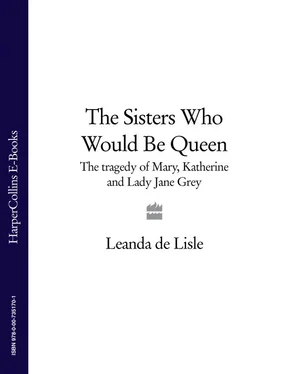The term Protestant only began to be used in England in the mid-1550s. 13 The more usual term for those we would now think of as Protestant was ‘evangelical’. They were so named because they wished to return to the ‘evangelium’ or ‘good news’ of the gospel, stripping away Church traditions they believed had no biblical basis in favour of a more fundamental reading of Scripture. There was no real orthodoxy within the English evangelicals, with individuals adhering to beliefs of varying degrees of radicalism, and people were careful not to express their views openly if they did not accord with the King’s. Dorset’s were later regarded, however, as being at the more radical end of the spectrum and Frances shared her husband’s beliefs. The ground was being prepared for an ideological struggle in which the Grey sisters, members of the first generation to be raised as evangelicals, were being groomed to play a significant role.
For Jane, being the elder of three sisters did not mean merely doing things first. She was the most important in rank. It was Jane in whom the Dorsets invested the lion’s share of their time and money, and to whom everyone else paid the most attention. While Jane was growing up - and until her death - the younger sisters remained in the shadows. They were at home, therefore, playing with their pets and learning their prayers, waiting for their own turn in the spotlight, when Jane, at nine, took her first steps on to the great national stage that was the King’s court.
In 1546, Jane’s mother was serving as a Lady of the Privy Chamber to Henry’s sixth wife, Catherine Parr. From time to time she could, therefore, bring Jane to court with her, to prepare her for a role as a Maid of Honour, serving the Queen. The court was the hub of political, cultural and social life in England. For a young girl such as Jane, however, it must have been often a confusing place. She could never be sure what lay behind a smile, or if what was said was what was meant, but amongst the gossiping courtiers and scheming bishops, the Queen, at least, struck a sympathetic figure. Catherine Parr was warm-hearted and intelligent, with a calm manner that invited confidence and respect. She was also a highly sensual woman: the kind that most attracted Henry. She wore gorgeous scarlet silks, bathed in milk baths, scented her body with rose water, and her breath with expensive, cinnamon lozenges. Beside this delicious vision, the fifty-five-year-old King appeared monstrous. It must have been difficult for Jane to imagine Henry as the ‘perfect example of manly beauty’ he had been described as in his youth. Pallid and obese, he was almost unable to walk on legs ruined by injuries acquired hunting and jousting. He spent most of his time in his private lodgings suffering fevers, but occasionally would emerge to be wheeled down the corridors of the royal palaces on chairs of tawny velvet; his eyes pinpoints of pain.
Henry did not have long to live, and with Edward only in his ninth year, it was apparent that all the blood spilled to secure the future of the Tudor dynasty could prove wasted. In the end he had exchanged the unknown consequences of female rule only for the familiar weaknesses of a royal minority. A young boy could not hope to fill the shoes of the old tyrant. Others would wield power on Edward’s behalf when he became King, and a ferocious struggle for that power had already begun. Although Jane was too young to grasp the subtleties of the shifting circles of interests manoeuvring around her, she surely understood that the most important battle lines concerned her faith. She knew too that the Queen was the leading evangelical at court. Catherine Parr had been wed twice before to old men and, still only in her early thirties she found in religion a passion that was absent in her marriages. She made energetic efforts to spread the new teaching in the universities and every afternoon evangelical chaplains preached to her ladies and their friends at court. Afterwards the women would sit with their guests and discuss what they had heard. There was a frisson of danger to this, for any divergence from the King’s beliefs risked accusations of heresy. And just how deadly that could be, Jane Grey’s family was soon to witness.
A group of religious conservatives on the Privy Council were plotting that summer to bring down their evangelical rivals. They intended to do so through an attack on their opponents’ wives. The means was to be a twenty-five-year-old gentlewoman called Anne Askew. A witty and articulate poet and evangelical, Askew had broken a taboo by disobeying her husband and quarrelling with him over religion. He had thrown her out, and she had subsequently been arrested for preaching that Christ was not really present in the consecrated bread and wine of the Mass. In June 1546 she had been condemned to death for heresy. But as Askew waited for sentence to be carried out, rumours leaked that she had allies in the Queen’s Privy Chamber. They were said to include the wives of leading evangelical Privy Councillors. According to an Elizabethan Jesuit, the conservatives learned that Askew had even been introduced to the Queen and the King’s ‘favourite nieces’, Frances Grey and her sister Eleanor. 14 The most likely person to have achieved such a coup was Frances’s widowed stepmother and childhood friend, the young Katherine Suffolk.
Blonde, blue-eyed, and charming when she wished to be, Katherine Suffolk was one of the most remarkable women of her time. Her temper and caustic wit were legendary. One of her contemporaries called her rages, ‘the Lady Suffolk heats’. 15 In the superficial world of the court, however, her contemporaries found her unusual directness and honesty both unnerving and attractive. She said what she thought, and what she thought was usually interesting and sometimes shocking. Although her Spanish mother had been Catherine of Aragon’s favourite lady-in-waiting, Katherine Suffolk despised the religion in which she was raised and was considered by foreign ambassadors to be ‘the greatest heretic in the kingdom’. She had huge influence with Catherine Parr and connections to Askew. The condemned woman’s brother-in-law, George St Poll, was a member of her household.
Askew was brought from Newgate to the Tower, where she was repeatedly tortured on the rack by two Privy Councillors in an effort to get her to name her court contacts. In the long and terrible history of the Tower no other woman is recorded as having been so treated. Askew was asked specifically about any connections she had to Katherine Suffolk, and it must have been a highly anxious time for the Grey family, as they wondered what Askew would reveal. But despite being torn apart ‘until the strings of her arms and eyes were perished’ Askew admitted only that a number of anonymous women had sent her money. 16 The news that a gentlewoman had been put to the rack then reached the public. That a gentlewoman should have been tortured at all appalled people, but that Askew was already a condemned prisoner, outraged them. In an effort to calm the public mood Askew was offered the opportunity to recant her views and receive a pardon. She refused and on 16th July 1546 was brought to Smithfield for execution by burning. Her body was so badly broken by the rack she had to be tied to the stake in a chair. The Queen’s cousin, Nicholas Throckmorton and two of his brothers, were there to shout out their support for her as she burned and died. Most of the ordinary people looking on were horrified at the cruelty, but they saw it often enough, meted out both to traditional Catholics burnt for ‘treason’ and radical evangelicals - ‘heretics’ - such as she.
Jane, Katherine and Mary Grey would have all learnt eventually the details of Askew’s death. The gentlewoman’s links to Katherine Suffolk, their step-grandmother, made her death almost a family matter. Her writings and the story of her life were soon, in any case, to be immortalised in a new evangelical cult of martyrdom, and they would have become familiar with Askew’s recorded words and actions in her last months. It underpinned the lesson with which they were inculcated: ‘Learn to die…’. 17 But it was Jane, being that much older, who was most deeply affected by Anne Askew’s example, and many of her later writings echoed Askew’s spirited and combative attacks on conservative beliefs.
Читать дальше












